Undefeated! The Bulls were 18-0 in the first round during the dynasty
Inside the numbers of our *first* run of 1st round sweeps

ANNOUNCEMENT: Thank you to everyone who continues to support A Shot on Ehlo! I am adding a “founding member” tier called The Breakfast Club, in honor of the early-morning workout crew of MJ, Scottie and Harp.
Membership in The Breakfast Club is $87 in honor of our 87 wins in 1996, a remarkable 87-13 record between regular season and the playoffs.
Breakfast Club members will receive an autographed copy of my book “WHY WE ROOT: Mad Obsessions of a Chicago Sports Fan.” When you sign up for The Breakfast Club, I will email you for your address and anything you want me to write on the book.
And if you are a free member and want to upgrade for $5/month or the better value of $33/year, you can unlock 36 stories, including all of my player interviews now and in the future, as well as interviews with Ray Clay, head of marketing Steve Schanwald, Chicago Stadium sound man Jim Irwin, Bulls ballboy Chris Mott, Carson Pirie Scott’s John Beachum, and MJ golf-and-gambling sparring partner Richard Esquinas.
Thanks everyone! Now onto the show.
We talk a lot in Bulls land about 6-0. And why not? Hard not to focus on a perfect Finals record.
But the Bulls had another perfect record that I always enjoyed as another mark of our dominance: 18-0. That’s 18 games in the best-of-five first round across six championship seasons, with zero losses.
No let-ups. No relaxing. Handling business, one 8 seed at a time1.
Let’s go inside the numbers on this perfect record. We’ll do the first three-peat now and the second three-peat next week.
First, an overview — full dynasty
1st three-peat:
2nd three-peat:
Stats that jump out:
The Bulls allowed 100 points in only four games: 1992 Game 3, 1993 Game 2, 1997 Game 2, 1998 Game 3.
MJ led the Bulls in scoring in all 18 first-round games
Only one Bull had a triple-double2 in these 18 games: Scottie Pippen in the 1996 clincher, with 22 points, 10 assists and an astounding 18 rebounds3. He also had three blocks and a steal.
Bulls in double figures: MJ/Pippen x18, B.J./Horace/Harper/Kukoc x5, Paxson/Kerr x3, Perdue/Rodman x2, Cartwright/Hodges/Levingston/Burrell/Longley x1
Jordan and Pippen are the only players in either three-peat to lead the team outright in any game in all four non-scoring categories: rebounds, assists, steals, blocks
The only two players other than MJ or Scottie to score 20+ in a first-round game: Toni did it in ‘96 Game 1, Scott Burrell did it in ‘98 Game 3.
After a wild 1997 playoffs in which he temporarily lost his starting job to Jason Caffey and had 18 technical fouls in 19 games4, Rodman had a strong return in 1998, starting in the first round against New Jersey, averaging just under 14 boards and leading us in rebounding in all three games.
Our biggest win was 41 points, against the Knicks in the first playoff game of the first title season. The biggest average margin of victory was 23 in 1996, spanking the Heat by 17, 31 and 21 points, respectively.
Lowest average margin of victory for a series? A meager six points against the Bullets in 1997, winning Game 1 by 12, Game 2 by 5 and Game 3 by 1 on the Pippen dunk.
Now, one of my favorite regular newspaper features: “Who has the edge?”
I absolutely loved the “Who has the edge?” breakdowns. As a fan, you enter a playoff series knowing you’ll be locked in on this team for a week or so, and you want to quickly put names and positions to faces.
The one mistake that papers of the 90s usually made, and maybe still do, is that they did the “edge” stories strictly by position and not by lineup tiers. Look at 1993. Yes, Stacey Augmon’s defense against Michael Jordan would be part of the story of the series, as would Scottie Pippen’s defense against Dominique Wilkins.
But most series also turn on which star performs best, no matter the position: MJ vs. Magic, Dominique, Sir Charles or Ewing, or a generation later, LeBron vs. Steph, Arenas, Duncan or Dwight.
That critique aside, the standard “edge” feature gave fans a shorthand for the matchups of a series and a taste of where our teams might win and where they might struggle.
Here are the “Who has the edge?” features for our three first-round series of the first three-peat, courtesy of newspapers.com.
1991: #1 Bulls (61-21, #2 in NBA) vs. #8 Knicks (39-43)
JACK NOTES
KNICKS:
This was New York’s final year without Pat Riley, who had left the Lakers after 1990. Riles would transform this rivalry, but several key players were already in place, namely Ewing and Oakley in the front court and new man off the bench John Starks.
Fun to see Trent Tucker in the starting lineup for the Knicks. Tucker won a game against the Bulls the year before when he hit a three with only 0.1 seconds on the clock. This led to the Trent Tucker Rule, stating that a catch-and-shoot was only legal with at least 0.3 seconds remaining. In the 1992 offseason, Tucker would sign with the Bulls and play a key role in Game 6 of the Finals, shooting 4-4 including one three-pointer in just seven minutes of play.
Also fun to see Kiki Vandeweghe in the Knicks lineup, as the former All-Star, who finished 2nd and 3rd in scoring in ‘83 and ‘84, respectively, was in the midst of a comeback season, playing 70 games for the first time since 1987 and averaging just over 16 points per game.
BULLS:
1991 was a historic year for the Bulls: their 25th in existence, their franchise high in wins (61), their first 60-win season, their second division title in franchise history after 1975 and their first year as the #1 seed.
One of two first-round series in Bulls title years with an average margin of victory of 20+ points.
SERIES:
Game 1: Bulls win by 41, still the largest playoff loss in Knicks history, and then the biggest win in Bulls playoff history, now third.
Game 3 featured MJ’s famous baseline dunk, the one where he wheeled around Starks and Oakley and jammed it on Ewing. I remember this being prominent in NBA promos of the day; I checked Inside Stuff on youtube and didn’t see it but that baseline camera angle was definitely a major early 90s NBA clip, along with obviously MJ’s switch-hands layup and the floor shot of rookie Shaq sliding and saving that ball over his head before crashing into the camera.
FAVORITE HIGHLIGHT: The aforementioned MJ baseline dunk:
And Scottie had two monster jams on Ewing two, one with each hand!
1992: #1 Bulls (67-15) vs. #8 Heat (38-44)
JACK NOTES
HEAT:
Like the ‘91 Knicks, the ‘92 Heat were a pre-Pat Riley team, though with even less relation to Riley’s powerful Heat teams of the late 90s. Instead, the Heat were coached by MJ’s first Bulls coach Kevin Loughery, in his first year in Miami.
This was Miami’s fourth season in existence and its first playoff berth. Of the four expansion teams added in 1989 (Heat, Hornets) and 1990 (Magic, Timberwolves), the Heat were the first to reach the playoffs, a massive swing considering they finished 15-67 in their inaugural year.
The Heat built the right way, as three of their first four top first-round picks were starters in ‘92: Rony Seikaly (1988, 9th pick), Glen Rice (1989, 4th pick) and Steve Smith (1991, 5th pick).
BULLS:
Despite controversy in the form of the publication of The Jordan Rules, MJ’s first gambling problems with the league office and the standard dissatisfaction that comes with successful teams, 1992 was a massive success for the Bulls. They set a new franchise record for wins with 67, six more than 1991, and unlike 1991 they had the best record in the NBA, not just in the East.
In September of 1991, the NBA announced the first 10 members of the Dream Team, and fresh off his championship, great Finals performance and new contract, Scottie Pippen was on the team ahead of Isiah Thomas and fellow small forwards Dominique Wilkins and James Worthy, both of whom ranked him in seniority. Pip had made the 1990 All-Star Game but was not selected in 1991; in 1992, he moved up from 5th in East forwards voting to 3rd behind only Charles Barkley and Larry Bird, and ended up starting the game when Larry couldn’t play. Scottie also earned his first of eight career 1st team defense selections and his first of seven All-NBA selections (2nd team).
Another big leap: Horace Grant. The General increased his FG%, FT%, points, rebounds and blocks, averaging double-figure boards for the first time.
SERIES:
Jordan drops 46, 33 and then 56 for 45.0 PPG, the second highest of any playoff series of his career.
Jordan’s 56 in Game 3 was his second highest playoff scoring total after his famed 63 against the Celtics.
The Bulls as a team shot 54% from the floor, their highest FG% in any playoff series in the championship years.
FAVORITE HIGHLIGHT: Jordan driving past and through all five Heat players on a winding, coast-to-coast drive, with a behind-the-back dribble and then cut back into the lane, ending with a two-handed dunk and a foul:
1993: #2 Bulls (57-25, #3 in NBA) vs. #7 Hawks (43-39)
JACK NOTES
HAWKS:
At age 33, Nique had a resurgence. His 29.9 points per game was 2nd behind MJ, his highest average in five years and the third highest PPG of his career. He was 2nd team All-NBA and 5th in MVP.
I can’t find a quote saying as much but it’s fair to wonder if Wilkins treated this entire season as a revenge game for being left off the Dream Team.
BULLS:
1993 was a grind. The Bulls entered the season with four straight years playing into June, two straight championships, and for MJ and Scottie, a summer with little rest due to the Dream Team. Phil allowed Jordan and Pippen to take it relatively easy in camp, frustrating Grant.
Pippen and Grant both took a step back statistically, while Jordan, despite his continued dominance, showed certain cracks. For the first time as a Bull, he missed a preseason game (three total) and played less than 80 games, playing 78, missing three games due to injury and one due to a suspension for his fight with Reggie Miller.
John Paxson battled injuries and lost his starting job to B.J. Armstrong, who continued to develop and improve.
For the first time since 1990, the Bulls won less than 60 games and did not have the #1 seed in the East, trailing the Knicks, as well as the Suns.
SERIES:
This is an underrated star matchup in NBA playoff history, the first and only time MJ and Dominique met in the playoffs. 1993 was one of three seasons when MJ and Nique finished 1-2 in the league in scoring.
Jordan won 10 scoring titles and faced the #2 scorer in the playoffs twice: Dominique in ‘93 and the Mailman in 97. Their regular season vs. playoff series:
1993 regular: Jordan 32.6, Nique 29.9
1993 1st round: Jordan 34.3, Nique 30.0
1997 regular: Jordan 29.6, Malone 27.4
1997 Finals: Jordan 32.3, Malone 23.8
FAVORITE HIGHLIGHT: Jordan again — sorry! — when he hit a half-court shot to end the first half of Game 2. Seeing Dominique walking away shaking his head with a slight smile tells the tale. Start at 2:14 here:
-
-
-
Coming next: a look at our three first-round sweeps of the second three-peat, against Miami, Washington and New Jersey. Have a great week!
Jack
When the 1st round got tough
“I’ve gone through it numerous times, but it’s still nerve-wracking for me to get out on the basketball court and start the first game of the playoffs. … You just have to go out the…

Okay, not quite. The Bulls were the top seed in the East in five of the six championship seasons. They were the 2 seed in 1993.
Per Stathead, the Bulls only have six playoff triple-doubles all-time, all from Pippen and Jordan. Scottie posted them in ‘90, ‘92, ‘93 and ‘96, including in Game 2 of the ‘93 Finals. His 18-rebound game in ‘96 was also the only one of his four playoff triple-doubles with 20+ points. Both of MJ’s playoff triple-doubles came against the Knicks: 34-10-12 in Game 1, 1989, and 29-10-14 in the Charles Smith Game.
This was a wild rebounding total for Pip. Today, there are 74 instances of a player bagging a playoff triple-double with 15+ rebounds, and the triple-double era opened this up, with these players all hitting for 18+ boards in a playoff triple-double: Jokic 6x, LeBron 3x, Duncan 2x, and one apiece for KG, Giannis, Westbrook, Draymond and Rondo. But back when Pippen did it in ‘96 there were only 42 such instances, 21 of which were with 18+ rebounds, and the only non-center / non-PF to pull it off were Tom Gola in 1960, Elgin in ‘61, Oscar in ‘63, Billy Cunningham in ‘71 and Bird in 1990.
Rodman had a solid but not up-to-par Finals in ‘97, but it was much better than what he did in the East playoffs when he could barely stay on the floor: hew drew technicals in 13 straight games and was ejected three times. Against the Bullets, he had a tech in each game, including a double-T in Game 1. In the entire ‘97 playoffs, Rodman had 160 rebounds against 74 fouls.

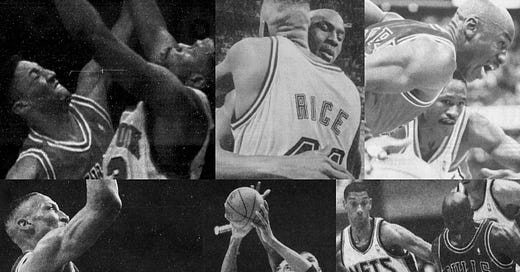




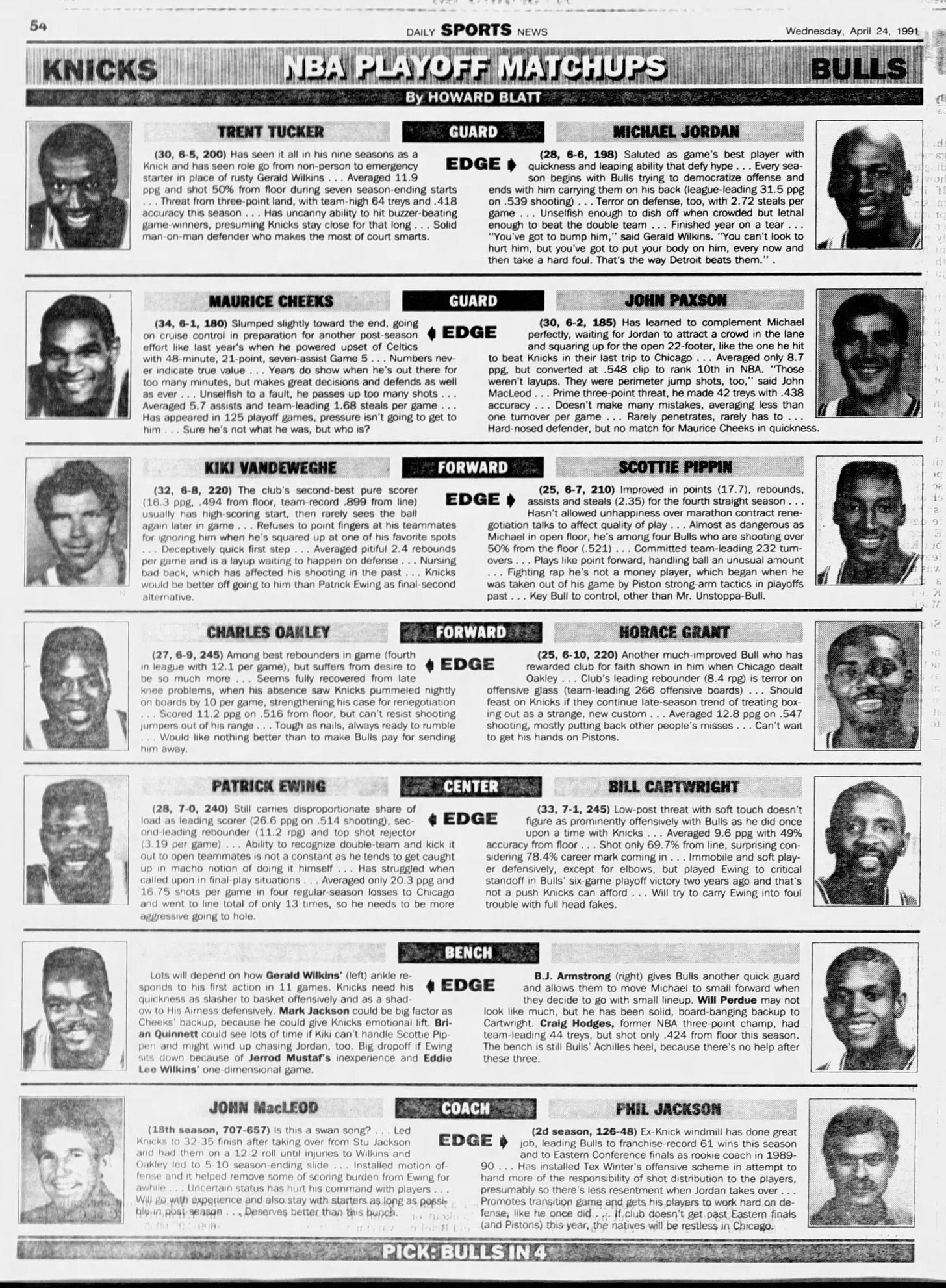
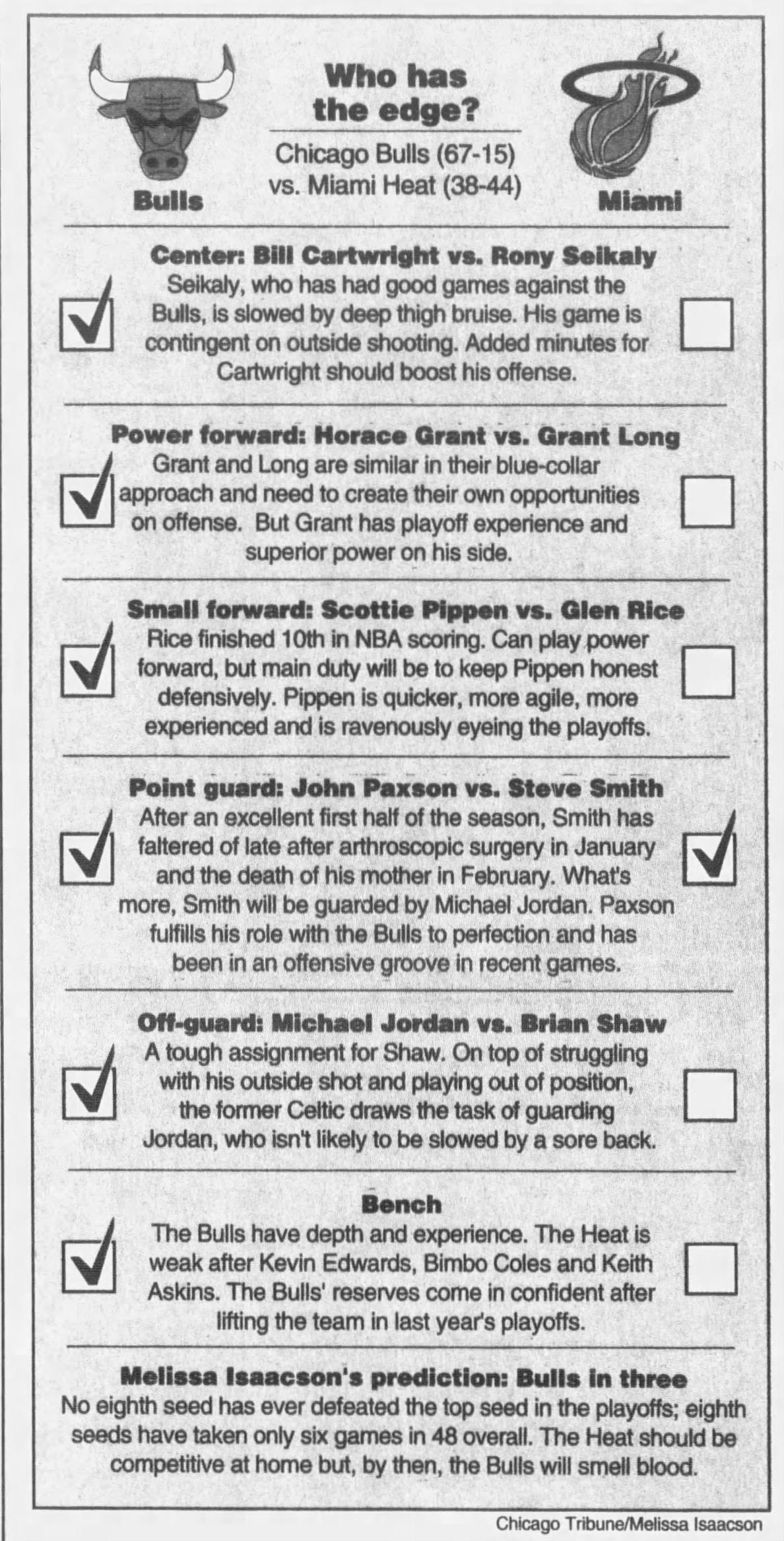



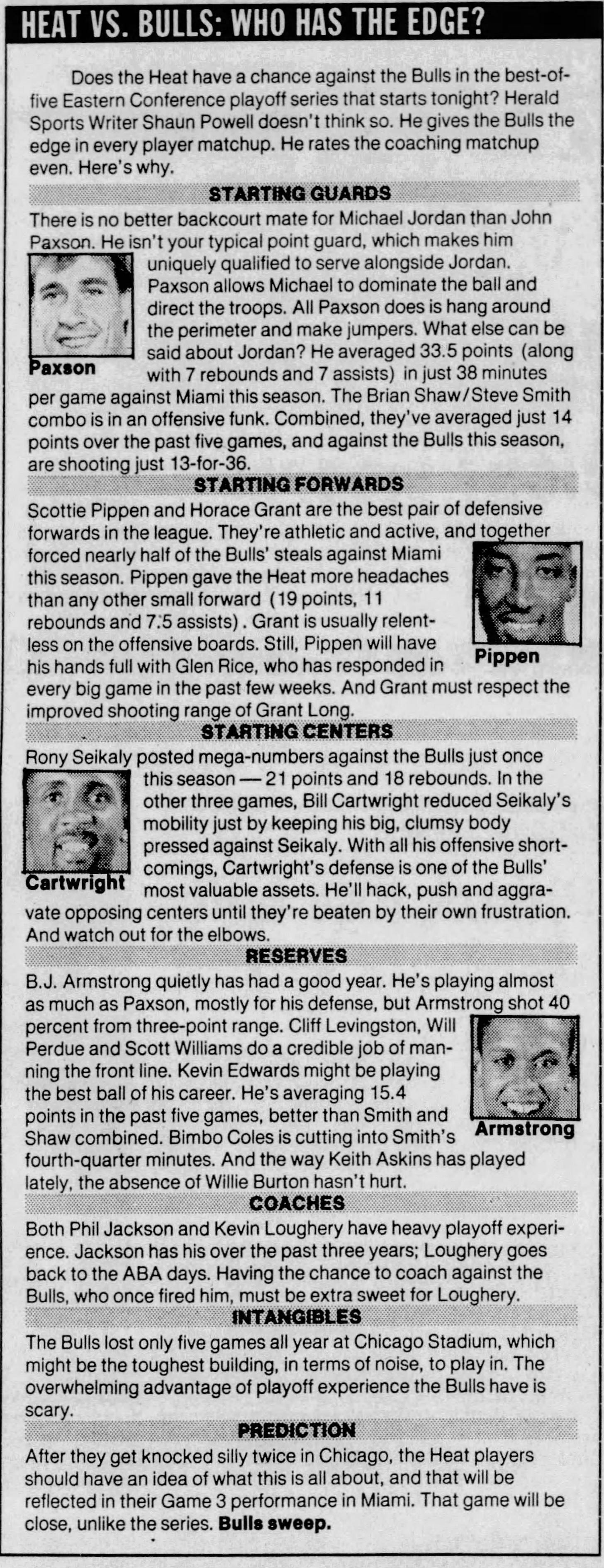


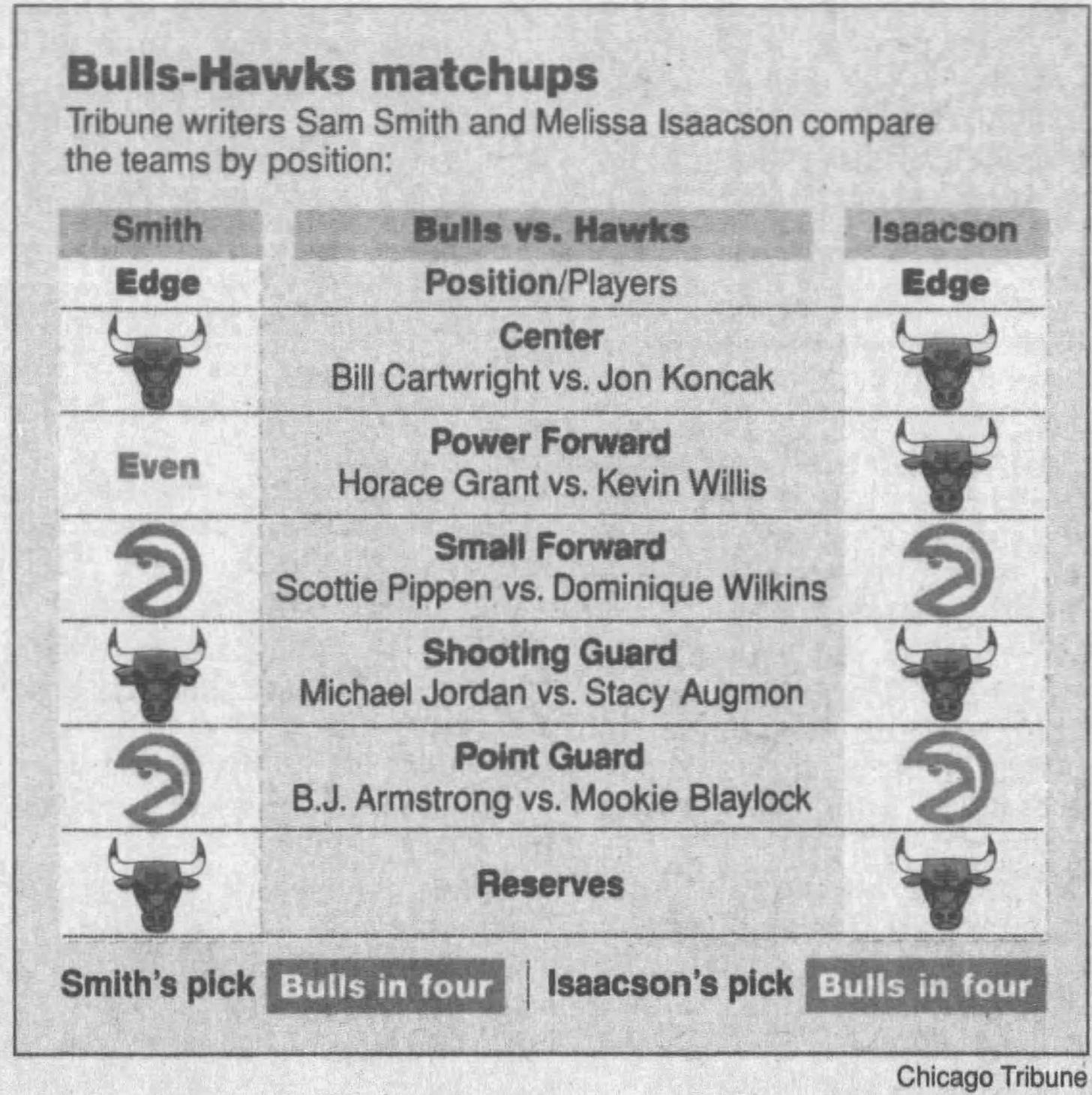

How did the Knicks not start the Jordan stopper in 91?! Wild, lol